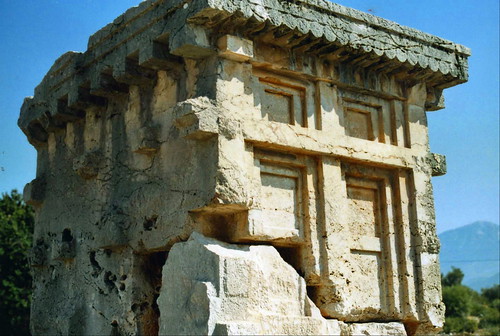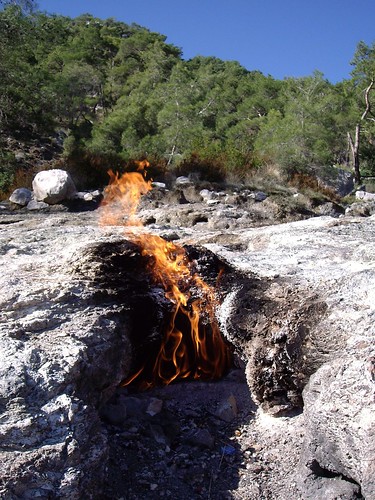Maybe its because Antony and Cleopatra did much of their romancing there, or perhaps its the azure sea, sandy beaches, traditional villages and lazy pace of life which make the Lycian coast in south west Turkey the ideal place for a romantic holiday – an experience that you can win in our Ancient World in London competition.
But the history of the Lycian Way is peppered as much with war as it is with romance, and its tumultous history helps make Lycia a fascinating area of Turkey to visit.
The mountainous, rugged territory behind the idyllic coastal scenery isolated Lycia from the rest of Anatolia, making the ancient Lycians fiercely independent and giving them a distinctive place in ancient Anatolian history. This independence caused the inhabitants of the chief city, Xanthos to make a funeral pyre of their own city and burn themselves alive rather than be conquered; first by the Persians circa 540 BC and the second time during the Roman civil war circa 42 BC when the inhabitants of Xanthos refused to assist Brutus.
Thought to be an indigenous pre-Hittite race, the Lycians had their own distinctive language and script and Herodotus wrote they reckon their lineage not by their fathers but by their mothers side.
The Lukkas of Lycia
 Ancient Egyptian records referred to the race as Lukka and indicate the Lycians were allies of the Hittites. When the Hittite Empire collapsed, they emerged as an independent Neo-Hittite kingdom.
Ancient Egyptian records referred to the race as Lukka and indicate the Lycians were allies of the Hittites. When the Hittite Empire collapsed, they emerged as an independent Neo-Hittite kingdom.
The Lycians were mentioned in the Iliad as allies of the Trojans, but in the 6th century BC, Lycia succumbed to the Persian Empire. After a little spat with Athens in 429BC, it was mostly left to rule itself during this time.
As an area Lycia organised itself to form the Lycian Federation. This was a democratic grouping, which consisted of 23 voting units and was charged with electing national officials and municipal authorities. These democratic principles are said to have influenced the United States constitution.
Lycia remained officially under Persian rule until it was conquered by Alexander the Great in 334-333BC. After his death, the Ptolemies ruled Lycia and Greek gradually replaced the Lycian language and Greek constitutions were adopted. Antiochus III defeated the Ptolemies in 197BC and he gave the kingdom to the Rhodians. This was bitterly disputed by the Lycians who succeeded in 167BC in having the relegation revoked.
The Lycians enjoyed a couple of centuries of semi-independence and the Lycian Federation came back into prominence.
In the Roman civil wars, after refusing to assist Brutus and gaining favour with Rome, Anthony reconfirmed Lycias autonomy and in 43AD the region was joined to Pamphylia. During this time, Lycias population reached around 200,000.
 Legend has it that the Lycian Federation prepared the island of Cedre (Sedir Adasi, also known as Cleopatras isle, situated off Marmaris) for the arrival of Cleopatra. To make Cleopatra feel at home, galleys full of sand was transported from Egypt to be strewn on the shore of Cedra. Analysis has since shown the sand isnt from local strata.
Legend has it that the Lycian Federation prepared the island of Cedre (Sedir Adasi, also known as Cleopatras isle, situated off Marmaris) for the arrival of Cleopatra. To make Cleopatra feel at home, galleys full of sand was transported from Egypt to be strewn on the shore of Cedra. Analysis has since shown the sand isnt from local strata.
Decline started to set in when the province was divided by Diocletian in the 4th century AD which deteriorated further with Arab raids in the 7th and 8th centuries.
The Chimera and Other Myths
The area enters into many Greek myths. Lycia is linked to Crete as it was ruled by King Minoss brother, Sarpedon, a Cretan exile.
The natural burning flames near Olympos, known as the eternal fires of Chimera, are also thought to be the root of the Chimera legend. This fire-breathing monster, with the head of a lion, body of a goat and tail of a snake terrorised the area and was eventually killed by Bellerophon.
As an aside, the silhouette of the Chimera is the logo for the state-run Petrol Ofisi Turkish filling stations.
Rock Cut Tombs
Much of the Lycian architecture has been overlaid with buildings from the Hellenistic and Roman periods. The most recognisable structures from Lycia are the rock-cut tombs in the side of cliffs throughout the area, such as the ones at Dalyan. Other ‘free standing’ Lycian tombs are said to depict an upturned boat.
There is also the Harpy Tomb which was found at Xanthos. Dating from circa 5th century BC, the marble-reliefed tomb was set on a thick pillar standing over 7m high.
As the original is now in the British Museum, a replica has been placed at the site. It should also be noted, the Trilingual Stele found at Letoon, the spiritual centre of Lycia, had instructions in Greek, Lycian and Aramaic and was crucial in deciphering the Lycian language (read more about trilingual texts and their role in decipherment here).
Lycia is a stunning area of Turkey and is steeped in an amazing, but bloody history. The Lycian Way is a popular destination for walkers who will receive a traditional warm Turkish welcome from locals as they travel the ancient route.
My advice is to stay away from the resorts, and wherever possible find a secluded olive grove to contemplate the past of this rugged, but beautiful area.
To be in with a chance of winning a holiday in ancient Lycia, dive into our Ancient World in London series, and start earning points.






